
HNUE JOURNAL OF SCIENCE
Natural Science, 2024, Volume 69, Issue 3, pp. 3-13
This paper is available online at http://hnuejs.edu.vn/ns
DOI: 10.18173/2354-1059.2024-0030
A NEW SPLITTING METHOD FOR MONOTONE INCLUSIONS
Nguyen Van Dung, Hoang Thi Kim Hoa, Nguyen Thi Hue and Ha Thi Thao
Department of Mathematical Analysis, University of Transport and Communications,
Hanoi city, Vietnam
*Corresponding author: Nguyen Van Dung, e-mail: dungnv@utc.edu.vn
Received September 17, 2024. Revised October 23, 2024. Accepted October 30, 2024.
Abstract. In this paper, we propose a splitting method for finding a zero point
of the sum of two operators in Hilbert spaces. Our method is a modification
of the forward-backward algorithm by using the inertial effect. Under the
imposed condition for parameters, weak convergence of the iterative sequence
is established. We also give some numerical experiments to demonstrate the
efficiency of the proposed algorithm.
Keywords: monotone inclusion, splitting method, inertial effect,
forward-backward algorithm.
1. Introduction
In this paper, we consider the problem of finding zero points of the sum of a
maximal monotone operator Aand a monotone, L−Lipschitzian operator B, acting on
a real Hilbert space H. The problem is specified as
find x∈ H such that 0∈(A+B)x. (1.1)
Throughout this paper, we assume that a solution xexists. This inclusion arises
in numerous problems in monotone operator theory, variational inequalities, convex
optimization, equilibrium problems, image processing, and machine learning; see [1]-[10]
and the references therein.
There are many methods for solving problem (1.1). These methods
exploit the splitting structure of (1.1) to use individual operators Aand B.
Classical methods include gradient, extragradient, past-extragradient, proximal-point,
forward-backward splitting, forward-backward-forward splitting, Douglas-Rachford
splitting, forward-reflected-backward splitting, reflected-forward-backward splitting,
3

Nguyen VD, Hoang TKH, Nguyen TH & Ha TT
golden ratio, projective splitting methods, and their variants, see for examples [5],
[11]-[15] for more details.
In this paper, we design a new method for solving problem (1.1). Our idea is
based on the forward-reflected-backward method, which is presented by Malitsky and
Tam in [14] and Polyak’s inertial technique [16]. In [14], the authors proposed the
forward-reflected-backward method (FRB), namely,
γ∈(0,+∞), xk+1 =JγA(xk−2γBxk+γBxk−1).(1.2)
where JAdenotes the resolvent of A, i.e.
JA= (Id +A)−1,
and Id is the identity operator on H.
In [16], Polyak introduced the so-called heavy ball method in order to speed up the
classical gradient method. For a differential function f:H → R, the algorithm takes the
following form:
xk+1 =xk+αk(xk−xk−1)−γk∇f(xk).
This idea is then employed and refined by some authors [17]-[20]. Our method also uses
the inertial effect to improve the performance of the algorithm. Unlike (1.2) which use
two values of operator Bat each iteration, we use three values of Bin each iteration.
Under some standard conditions, we also obtain the convergence of the proposed method.
In some examples, our method gives better convergence rate than Tseng’s method [12]
and the FRB method in [14].
2. Preliminaries
The scalar product and the associated norm of the real Hilbert space Hare denoted
respectively by ⟨· | ·⟩ and ∥ · ∥.
The symbols ⇀and →denote respectively weak and strong convergence.
Let A:H → 2Hbe a set-valued operator. The domain of A, denoted by
dom(A), is set of all x∈ H such that Ax =∅. The range of Ais defined by
ran(A) = u∈ H | (∃x∈ H)u∈Ax. The graph of Ais denoted by gra(A) =
(x, u)∈ H × H | u∈Ax.A−1stands for the inverse of A, i.e., A−1:u7→
x|u∈Ax. The zero set of Ais zer(A) = A−10.
Definition 2.1. [11] We say that operator A:H → 2His
1. monotone if
∀(x, u)∈gra(A)∀(y, v)∈gra(A)⟨x−y|u−v⟩ ≥ 0.
4

A new splitting method for monotone inclusions
2. maximally monotone if it is monotone and there exists no monotone operator
B:H → 2Hsuch that gra(B)properly contains gra(A), i.e., there is no monotone
operator that properly contains it.
Definition 2.2. [11] A mapping T:H → H is said to be L-Lipschitz continuous (L > 0)
if
∥T x −T y∥ ≤ L∥x−y∥ ∀x, y ∈ H.
Definition 2.3. [11] For A:H → 2H, the resolvent of operator Ais
JA= (Id +A)−1,
where Id denotes the identity operator on H.
Note that, when Ais maximally monotone, JAis an everywhere single-valued
operator [11].
3. Proposed method and convergence
We propose the following method for solving problem (1.1).
Algorithm 3.1. Let γ > 0, and α≥0. Let x−1, x0, x1∈ H. Iterate (∀k∈N)
xk+1 =JγAhxk+α(xk−xk−1)−γ5
2Bxk−2Bxk−1+1
2Bxk−2i.(3.1)
Let us give some comments on the above algorithm.
1. In (3.1), in each iteration, we have to calculate three forward values. However, in the
next iteration, we can use two forward values of the previous iteration. Therefore,
we actually only compute one forward value in every iteration.
2. When α= 0, B = 0, Algorithm 3.1 becomes the proximal point algorithm as
in [21].
To prove the convergence of Algorithm 3.1, we need the following lemma.
Lemma 3.1. Suppose that (xk)k∈Nis the sequence generated by Algorithm 3.1. Then, for
any x∈zer(A+B), we get
∥xk+1 −x∥2−α∥xk−x∥2+ 2γtk+1 +1−α−3γL
2∥xk+1 −xk∥2
≤ ∥xk−x∥2−α∥xk−1−x∥2+ 2γtk+ (2α+γL)∥xk−xk−1∥2+γL
2∥xk−1−xk−2∥2,
(3.2)
where tk=⟨Bxk−1−Bxk|xk−x⟩+1
2⟨Bxk−1−Bxk−2|xk−x⟩.
5

Nguyen VD, Hoang TKH, Nguyen TH & Ha TT
Proof. From (3.1), we get
xk+α(xk−xk−1)−xk+1
γ−5
2Bxk−2Bxk−1+1
2Bxk−2∈Axk+1.(3.3)
For x∈zer(A+B),then −Bx ∈Ax. Hence,
xk+α(xk−xk−1)−xk+1
γ−5
2Bxk+ 2Bxk−1−1
2Bxk−2+Bx |xk+1 −x≥0,
which implies
xk−xk+1 +α(xk−xk−1)
γ|xk+1 −x
≥5
2Bxk−2Bxk−1+1
2Bxk−2−Bx |xk+1 −x.(3.4)
For the left-hand side of (3.4), we have
⟨xk−xk+1 +α(xk−xk−1)|xk+1 −x⟩
=⟨xk−xk+1 |xk+1 −x⟩+α⟨xk−xk−1|xk+1 −xk⟩+α⟨xk−xk−1|xk−x⟩
=1
2∥xk−x∥2− ∥xk+1 −x∥2− ∥xk+1 −xk∥2
−α
2∥xk−1−x∥2− ∥xk−x∥2− ∥xk−1−xk∥2+α⟨xk−xk−1|xk+1 −xk⟩.
(3.5)
Using the monotonicity of B, we estimate the right-hand side of (3.4) as
5
2Bxk−2Bxk−1+1
2Bxk−2−Bx |xk+1 −x
=5
2Bxk−2Bxk−1+1
2Bxk−2−Bx −Bxk+1 |xk+1 −x
+⟨Bxk+1 −Bx |xk+1 −x⟩
≥ ⟨Bxk−Bxk+1 |xk+1 −x⟩+3
2⟨Bxk−Bxk−1|xk+1 −x⟩
−1
2⟨Bxk−1−Bxk−2|xk+1 −x⟩
=⟨Bxk−Bxk+1 |xk+1 −x⟩+1
2⟨Bxk−Bxk−1|xk+1 −x⟩
+⟨Bxk−Bxk−1|xk+1 −xk⟩+⟨Bxk−Bxk−1|xk−x⟩
−1
2⟨Bxk−1−Bxk−2|xk+1 −xk⟩+⟨Bxk−1−Bxk−2|xk−x⟩
=tk+1 −tk+⟨Bxk−Bxk−1|xk+1 −xk⟩ − 1
2⟨Bxk−1−Bxk−2|xk+1 −xk⟩.(3.6)
6

A new splitting method for monotone inclusions
Hence, from (3.4), (3.5) and (3.6), we can deduce
∥xk−x∥2− ∥xk+1 −x∥2− ∥xk+1 −xk∥2
−α∥xk−1−x∥2− ∥xk−x∥2− ∥xk−1−xk∥2
≥2γtk+1 −2γtk+ 2γ⟨Bxk−Bxk−1|xk+1 −xk⟩
−γ⟨Bxk−1−Bxk−2|xk+1 −xk⟩ − 2α⟨xk−xk−1|xk+1 −xk⟩.(3.7)
Using Cauchy-Schwarz inequality and the Lipschitz property of B, we have
2| ⟨Bxk−Bxk−1|xk+1 −xk⟩ | ≤ L(∥xk−xk−1∥2+∥xk+1 −xk∥2),
2| ⟨Bxk−1−Bxk−2|xk+1 −xk⟩ | ≤ L(∥xk−1−xk−2∥2+∥xk+1 −xk∥2),
2| ⟨xk−xk−1|xk+1 −xk⟩ | ≤ ∥xk−xk−1∥2+∥xk+1 −xk∥2.
Therefore, (3.7) implies that
∥xk−x∥2− ∥xk+1 −x∥2− ∥xk+1 −xk∥2
−α∥xk−1−x∥2− ∥xk−x∥2− ∥xk−1−xk∥2
≥2γtk+1 −2γtk−γL(∥xk−xk−1∥2+∥xk+1 −xk∥2)
−γL
2(∥xk−1−xk−2∥2+∥xk+1 −xk∥2)−α(∥xk−xk−1∥2+∥xk+1 −xk∥2),
which is equivalent to
∥xk+1 −x∥2−α∥xk−x∥2+ 2γtk+1 +1−α−3γL
2∥xk+1 −xk∥2
≤ ∥xk−x∥2−α∥xk−1−x∥2+ 2γtk+ (2α+γL)∥xk−xk−1∥2+γL
2∥xk−1−xk−2∥2.
The proof is completed.
The convergence of Algorithm 3.1 is presented in the following theorem.
Theorem 3.2. Let (xk)k∈Nbe the sequence generated by Algorithm 3.1 with α∈[0,1
3),
and assume that
γ < 1−3α
3L.(3.8)
Then (xk)k∈Nconverges weakly to x∈zer(A+B).
7

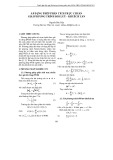
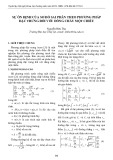
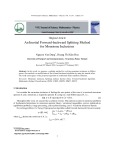
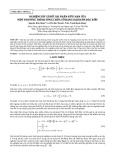
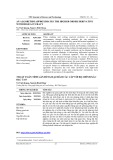
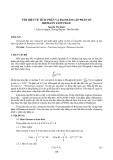
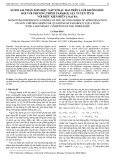
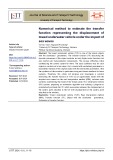
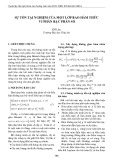















![Quyển ghi Xác suất và Thống kê [chuẩn nhất]](https://cdn.tailieu.vn/images/document/thumbnail/2025/20251030/anh26012006/135x160/68811762164229.jpg)
